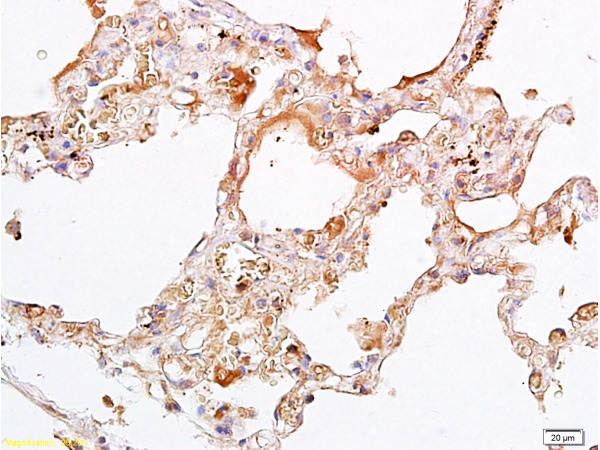Oct4 antibody [GT486]
GTX627419
ApplicationsFlow Cytometry, ImmunoFluorescence, ImmunoPrecipitation, Western Blot, ImmunoCytoChemistry, ImmunoHistoChemistry, ImmunoHistoChemistry Paraffin
Product group Antibodies
TargetPOU5F1
Overview
- SupplierGeneTex
- Product NameOct4 antibody [GT486]
- Delivery Days Customer9
- Application Supplier NoteWB: 1:500-1:3000. ICC/IF: 1:100-1:1000. IHC-P: 1:100-1:1000. FACS: 1:50-1:200. IP: 1:1000-1:1000. *Optimal dilutions/concentrations should be determined by the researcher.Not tested in other applications.
- ApplicationsFlow Cytometry, ImmunoFluorescence, ImmunoPrecipitation, Western Blot, ImmunoCytoChemistry, ImmunoHistoChemistry, ImmunoHistoChemistry Paraffin
- CertificationResearch Use Only
- ClonalityMonoclonal
- Clone IDGT486
- Concentration1 mg/ml
- ConjugateUnconjugated
- Gene ID5460
- Target namePOU5F1
- Target descriptionPOU class 5 homeobox 1
- Target synonymsOCT3, OCT4, OCT4Borf1, OTF-3, OTF3, OTF4, Oct-3, Oct-4, Oct3/4, POU domain, class 5, transcription factor 1, POU domain transcription factor OCT4, POU-type homeodomain-containing DNA-binding protein, octamer-binding protein 3, octamer-binding protein 4, octamer-binding transcription factor 3
- HostMouse
- IsotypeIgG2a
- Protein IDQ01860
- Protein NamePOU domain, class 5, transcription factor 1
- Scientific DescriptionThis gene encodes a transcription factor containing a POU homeodomain. This transcription factor plays a role in embryonic development, especially during early embryogenesis, and it is necessary for embryonic stem cell pluripotency. A translocation of this gene with the Ewings sarcoma gene, t(6;22)(p21;q12), has been linked to tumor formation. Alternative splicing, as well as usage of alternative translation initiation codons, results in multiple isoforms, one of which initiates at a non-AUG (CUG) start codon. Related pseudogenes have been identified on chromosomes 1, 3, 8, 10, and 12. [provided by RefSeq]
- Storage Instruction-20°C or -80°C,2°C to 8°C
- UNSPSC12352203
References
- Heparanase regulates EMT and cancer stem cell properties in prostate tumors.Read more
- Selective Proliferation of Highly Functional Adipose-Derived Stem Cells in Microgravity Culture with Stirred Microspheres. Mashiko T et al., 2021 Mar 4, CellsRead more
- Upregulation of CD109 Promotes the Epithelial-to-Mesenchymal Transition and Stemness Properties of Lung Adenocarcinomas via Activation of the Hippo-YAP Signaling. Lee KY et al., 2020 Dec 25, CellsRead more
- The acidic tumor microenvironment drives a stem-like phenotype in melanoma cells. Andreucci E et al., 2020 Oct, J Mol Med (Berl)Read more
- From ACTH-Dependent to ACTH-Independent Cushings Syndrome from a Malignant Mixed Corticomedullary Adrenal Tumor: Potential Role of Embryonic Stem Cells. Ramirez-Renteria C et al., 2020, Case Rep EndocrinolRead more
- Mitochondrial DNA alterations may influence the cisplatin responsiveness of oral squamous cell carcinoma. Aminuddin A et al., 2020 May 12, Sci RepRead more
- Generation of an iPSC line (HUSTi002-A) from fibroblasts of a patient with Sertoli cell-only syndrome carrying c.731_732delAT in PIWIL2 gene. Wang X et al., 2020 Jan, Stem Cell ResRead more
- ERK Activation Modulates Cancer Stemness and Motility of a Novel Mouse Oral Squamous Cell Carcinoma Cell Line. Chen YL et al., 2019 Dec 24, Cancers (Basel)Read more
- In silico identification of thiostrepton as an inhibitor of cancer stem cell growth and an enhancer for chemotherapy in non-small-cell lung cancer. Huang TH et al., 2019 Dec, J Cell Mol MedRead more
- Enrichment of superoxide dismutase 2 in glioblastoma confers to acquisition of temozolomide resistance that is associated with tumor-initiating cell subsets. Chien CH et al., 2019 Oct 19, J Biomed SciRead more




![IHC-P analysis of human testes, seminoma tissue using GTX01931 Oct4 antibody [N1NK]. Note nuclear staining of neoplastic cells.](https://www.genetex.com/upload/website/prouct_img/normal/GTX01931/GTX01931_20200811_IHC-P_65_w_23053121_845.webp)
![IHC-P analysis of human endometrium tissue using GTX83850 Oct4 antibody [9B7]. Antigen retrieval : Heat-induced epitope retrieval by 10mM citrate buffer, pH6.0, 100oC for 10min.](https://www.genetex.com/upload/website/prouct_img/normal/GTX83850/GTX83850_1927_IHC-P_w_23061420_711.webp)

![FACS analysis of Jurkat cells using GTX82755 Oct4 antibody [7E7]. Green : Oct4 Purple : negative control](https://www.genetex.com/upload/website/prouct_img/normal/GTX82755/GTX82755_20170912_FACS_w_23061322_841.webp)
![WB analysis of PMA treated HepG2 cell lysate using GTX83020 Oct4 antibody [3A5].](https://www.genetex.com/upload/website/prouct_img/normal/GTX83020/GTX83020_20170912_WB_w_23061322_182.webp)